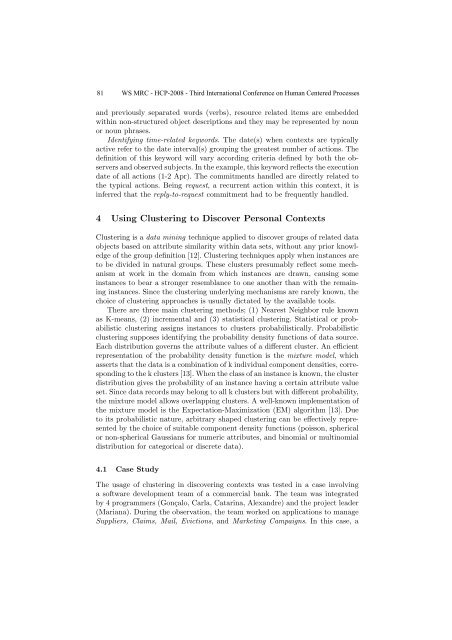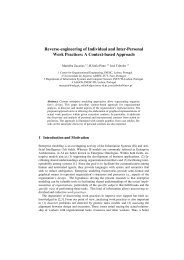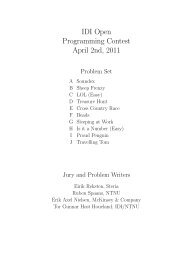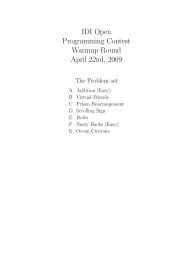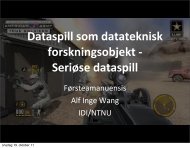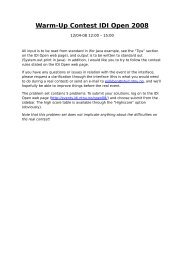Automatic discovery of personal action contexts - CiteSeerX
Automatic discovery of personal action contexts - CiteSeerX
Automatic discovery of personal action contexts - CiteSeerX
You also want an ePaper? Increase the reach of your titles
YUMPU automatically turns print PDFs into web optimized ePapers that Google loves.
81 WS MRC - HCP-2008 - Third International Conference on Human Centered Processesand previously separated words (verbs), resource related items are embeddedwithin non-structured object descriptions and they may be represented by nounor noun phrases.Identifying time-related keywords. The date(s) when <strong>contexts</strong> are typicallyactive refer to the date interval(s) grouping the greatest number <strong>of</strong> <strong>action</strong>s. Thedefinition <strong>of</strong> this keyword will vary according criteria defined by both the observersand observed subjects. In the example, this keyword reflects the executiondate <strong>of</strong> all <strong>action</strong>s (1-2 Apr). The commitments handled are directly related tothe typical <strong>action</strong>s. Being request, a recurrent <strong>action</strong> within this context, it isinferred that the reply-to-request commitment had to be frequently handled.4 Using Clustering to Discover Personal ContextsClustering is a data mining technique applied to discover groups <strong>of</strong> related dataobjects based on attribute similarity within data sets, without any prior knowledge<strong>of</strong> the group definition [12]. Clustering techniques apply when instances areto be divided in natural groups. These clusters presumably reflect some mechanismat work in the domain from which instances are drawn, causing someinstances to bear a stronger resemblance to one another than with the remaininginstances. Since the clustering underlying mechanisms are rarely known, thechoice <strong>of</strong> clustering approaches is usually dictated by the available tools.There are three main clustering methods; (1) Nearest Neighbor rule knownas K-means, (2) incremental and (3) statistical clustering. Statistical or probabilisticclustering assigns instances to clusters probabilistically. Probabilisticclustering supposes identifying the probability density functions <strong>of</strong> data source.Each distribution governs the attribute values <strong>of</strong> a different cluster. An efficientrepresentation <strong>of</strong> the probability density function is the mixture model, whichasserts that the data is a combination <strong>of</strong> k individual component densities, correspondingto the k clusters [13]. When the class <strong>of</strong> an instance is known, the clusterdistribution gives the probability <strong>of</strong> an instance having a certain attribute valueset. Since data records may belong to all k clusters but with different probability,the mixture model allows overlapping clusters. A well-known implementation <strong>of</strong>the mixture model is the Expectation-Maximization (EM) algorithm [13]. Dueto its probabilistic nature, arbitrary shaped clustering can be effectively representedby the choice <strong>of</strong> suitable component density functions (poisson, sphericalor non-spherical Gaussians for numeric attributes, and binomial or multinomialdistribution for categorical or discrete data).4.1 Case StudyThe usage <strong>of</strong> clustering in discovering <strong>contexts</strong> was tested in a case involvinga s<strong>of</strong>tware development team <strong>of</strong> a commercial bank. The team was integratedby 4 programmers (Gonçalo, Carla, Catarina, Alexandre) and the project leader(Mariana). During the observation, the team worked on applications to manageSuppliers, Claims, Mail, Evictions, andMarketing Campaigns. In this case, a


